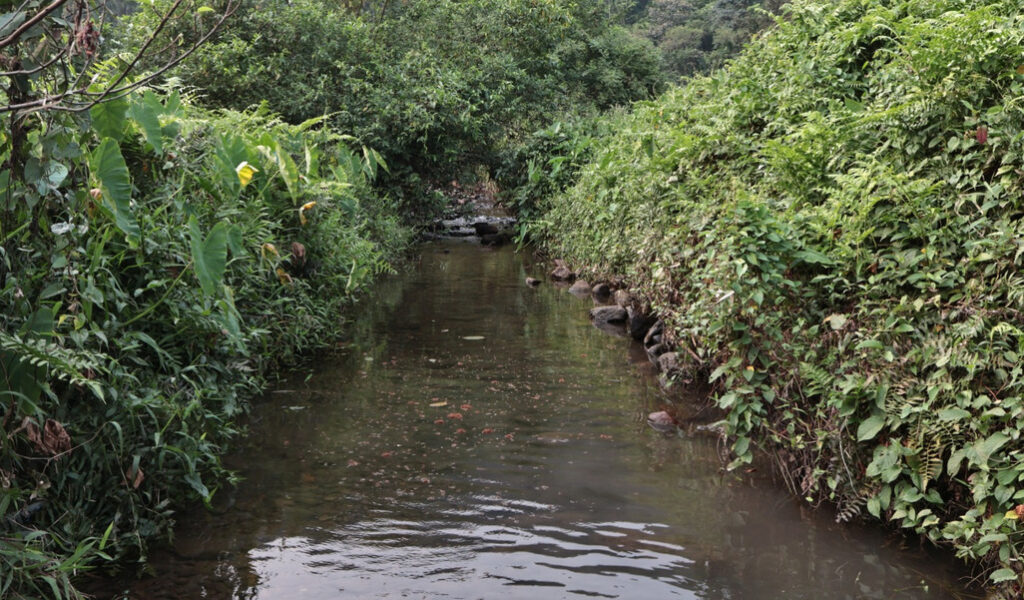Shillong, Nov 19: The Pyrngang stream, near Lakroh village in Meghalaya has become the focal point of global scientific attention with the discovery of Oreichthys warjaintia, a new species of freshwater fish.
The fish, belonging to the cyprinid family, was identified during a survey in May 2024 by researchers from the Kerala University of Fisheries and Ocean Studies (KUFOS). Nestled close to the India-Bangladesh border, the Pyrngang stream is part of the Surma-Meghna river basin. The researchers are Lekiningroy Dann, Neelesh Dahanukar and Rajeev Raghavan.

“Pyrngang stream is a unique ecosystem,” said lead researcher Lekiningroy Dann. “It flows gently through sand, gravel, and pebbles, bordered by pristine vegetation. Its beauty masks its ecological importance, as small streams like this are often overlooked despite being critical for biodiversity.”
The Pyrngang stream originates in the hills of Amlanai village, just kilometers from the international border. It meanders through quiet landscapes before merging with the Boro Gang River, a tributary of the Surma-Meghna basin. During their survey, scientists collected five specimens of Oreichthys warjaintia, which were analyzed to confirm their uniqueness.

The fish’s discovery underscores the stream’s ecological value, highlighting its role as a haven for unique species. With its sandy and rocky substrate, slow-moving waters, and riparian vegetation, the Pyrngang creates a microhabitat that fosters both aquatic and terrestrial biodiversity.
For the local War-Jaintia community, the stream is more than a natural feature—it is a part of their cultural and environmental heritage. The new species’ name, Oreichthys warjaintia, honors the community’s deep connection to the region and its natural resources.

What Makes Oreichthys warjaintia Special?
The new fish is characterized by its striking features, including a complete lateral line with 25–27 pored scales, a deep body, and bright orange dorsal fins adorned with black bars. A genetic analysis revealed significant divergence from related species like Oreichthys cosuatis, further confirming it as a distinct species.
Despite its beauty and uniqueness, Oreichthys warjaintia is currently known only from the Pyrngang stream. This narrow range makes it particularly vulnerable to habitat degradation and environmental changes.
The Importance of Preserving Small Streams
The discovery of Oreichthys warjaintia draws attention to the need for conservation in small, unassuming water bodies like the Pyrngang stream. As researchers point out, these habitats often go unnoticed compared to larger rivers but play an outsized role in preserving regional biodiversity.

“Streams like Pyrngang are the lifeblood of local ecosystems,” said co-author Dr. Rajeev Raghavan. “They support not just fish but a range of aquatic and terrestrial species. Protecting them is essential not only for biodiversity but also for the well-being of local communities who depend on these water bodies.”
Conservationists are calling for increased protection of the Pyrngang and similar streams in Meghalaya. Unregulated development, pollution, and changes in land use pose significant threats to these ecosystems.
Meghalaya’s Hidden Biodiversity
Meghalaya, part of the Eastern Himalaya biodiversity hotspot, is home to many species yet to be formally identified. The discovery of Oreichthys warjaintia is a testament to the region’s ecological wealth and the potential for further scientific exploration.

The Pyrngang stream and its surrounding hills serve as a reminder of the delicate balance in ecosystems. Efforts to protect such habitats will not only safeguard species like Oreichthys warjaintia but also promote sustainable livelihoods for communities that have coexisted with nature for centuries.
A Partnership With Local Communities
The War-Jaintia community played a crucial role in facilitating the discovery, offering hospitality and knowledge of the local environment. Their collaboration with researchers highlights the importance of integrating local expertise in biodiversity studies.
The study was supported by the Ministry of Tribal Affairs, Government of India, and published in the Journal of Fish Biology. Researchers hope the findings will inspire conservation efforts not just in Meghalaya but across India, where many such hidden ecosystems are waiting to be explored and protected.
Read: Body of sixth abducted family member found in Barak river, Assam
WATCH:
Find latest news from every corner of Northeast India at hubnetwork.in, your online source for breaking news, video coverage.
Also, Follow us on-
Twitter-twitter.com/nemediahub
Youtube channel- www.youtube.com/@NortheastMediaHub2020
Instagram- www.instagram.com/ne_media_hub
Download our app from playstore – Northeast Media Hub





